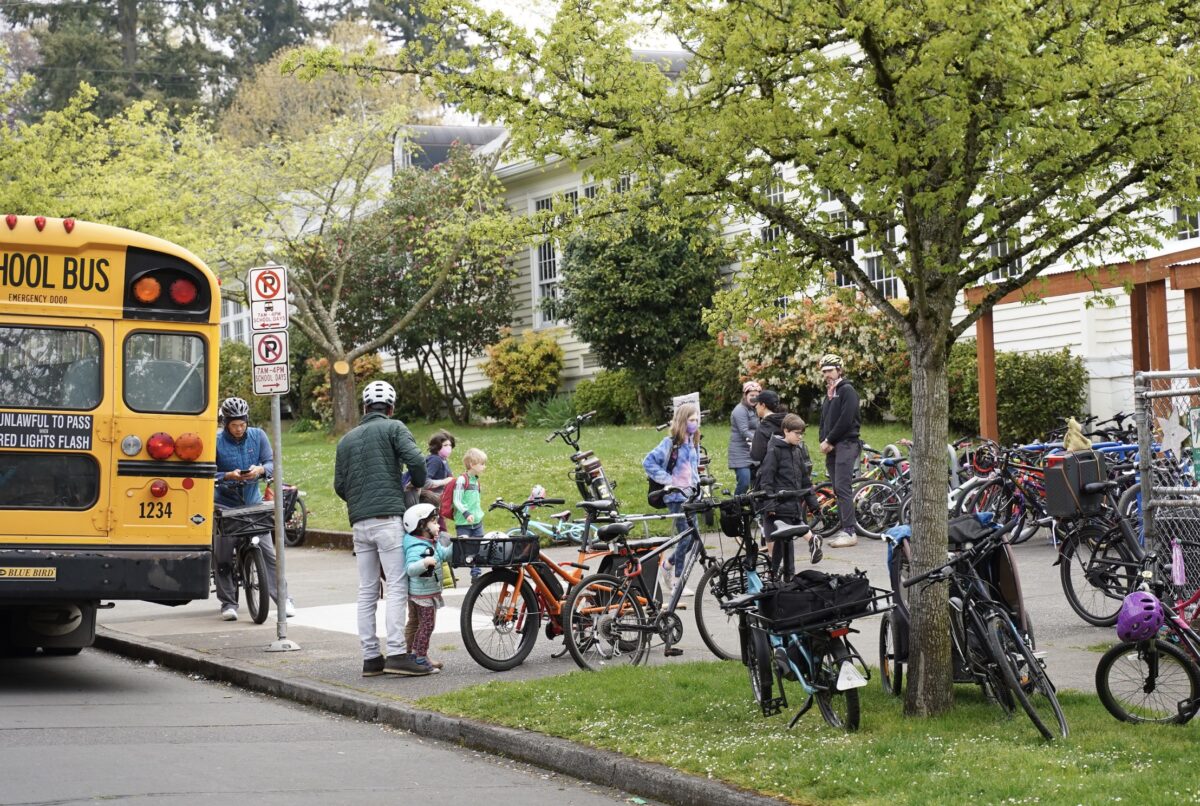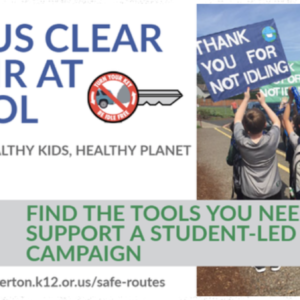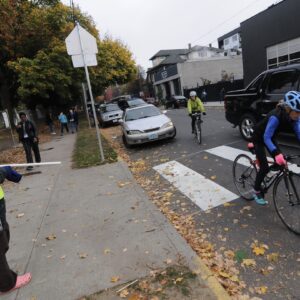
School’s almost out for summer vacation for many students in Oregon. But transportation planners in their cities and school districts are already thinking past Labor Day, eager to make it easier for students and parents to use active transportation to get to school. Through the Oregon Department of Transportation’s Safe Routes to School program, school districts have the opportunity to apply for grants for infrastructure and non-infrastructure projects to encourage and facilitate safe ways for kids to walk, bike or roll to school.
“Supporting multimodal transportation such as walking and rolling is a key part of ODOT’s Strategic Action Plan,” an ODOT press release about recent grant awards says. “The Safe Routes to School Program helps Oregon communities make it easier to choose alternate modes of travel.”
The Portland Bureau of Transportation has its own Safe Routes to School program, as do other communities around the state, like Eugene-Springfield, Salem-Keizer and Beaverton. These programs receive funding from local sources, like Portland’s gas tax and Metro. But statewide funding adds an extra boost to projects, and can be especially beneficial in rural areas, including tribal communities.
ODOT’s Safe Routes to School funding addresses both non-infrastructure and infrastructure needs in a school community. On the non-infrastructure side, ODOT funding will enable school districts to do things like hire district Safe Routes to School coordinators who can lead educational and awareness campaigns. These coordinators may also be able to connect school districts to their city transportation departments to access funding for direct infrastructure projects.
ODOT awarded 13 education grants throughout the state to fund these education programs for the 2023 and 2024 fiscal years. Cities throughout Oregon are represented on the list, from La Grande to Medford. The four education grants awarded to Portland-area programs are as follows:
Portland Public Schools, $100,000 grant + $50,000 Consultation Services paid for by ODOT
PPS wants to be an active leader and champion of a district-wide SRTS program. We believe outcomes of SRTS program will result in a better place not only for our children but all city residents. A city where residents are safer, healthier, happier and better connected. The systematic SRTS approach starts with a full-time dedicated PPS SRTS Coordinator who will work with a consultant to develop an Implementation Plan. This plan will create a vision for a district-wide SRTS Program, as well as establish objectives, goals and initiatives that are meaningful to the youth they serve. The first phase of the plan will focus primarily on PPS’ 38 high-need schools, with priority given to elementary and middle schools that score higher in the TDI. Additionally, we will bring together the right people to form a PPS-led SRTS Advisory Committee, with participation from our supporting partners. The committee will meet regularly to evaluate, make improvements and keep the program moving forward. Consistent and clear communication will be essential for a strong SRTS program. The Coordinator will work closely with PPS Communications to reach our target audience(s).
Bike Works by P:ear, $100,000 grant + $50,000 Consultation Services paid for by ODOT
Bike Works by P:ear will continue its partnership with Multnomah County’s SRTS to deliver transportation health programming to East County with a full time SRTS coordinator. We are in a unique position to broaden our abilities across jurisdictions, expand the current SRTS program, work collaboratively with other SRTS practitioners, and create equitable transportation options for the community. During 2022-2023, we will continue to provide lessons and outreach with Multnomah County SRTS and transition to providing the majority of in-person lessons by 2023- 2024.
City of Portland, Portland Bureau of Transportation (PBOT), $35,000
Portland Bureau of Transportation (PBOT) SRTS staff will train Elevate Oregon’s high school teacher mentors to lead a Transportation Academy. The Academy’s main goal is to teach traffic safety skills. Secondary topics will be decided depending on the students’ needs, interests, and goals. Topics include multimodal literacy, climate connections, transportation equity, civic engagement, and Safe Systems. The Academy consists of lessons led by Elevate teachers, subject matter experts as speakers, student projects, and a final student presentation. Student projects can include but are not limited to educating younger students on traffic safety, photo voice, serving as walking school bus leaders or corner greeters, or creating a safety messaging campaign. Presentation types will depend on the project and will be crafted to benefit elementary or middle school students in the Parkrose community. These presentations will be either during school or in the after-school program, Schools Uniting Neighborhoods (SUN).This innovative project not only engages high school students but benefits elementary and middle school students as well through educational presentations.
Beaverton School District, $87,722
The Beaverton Safe Routes to School Program will work to increase active transportation (bike, scooter, skateboard, bus, and carpool) to school and decrease single passenger trips. The objective is to increase safety for students as they travel to and from school, increase the opportunity for students to confidently choose to use active transportation modes, and ultimately, increase the safety and health of the entire community through the reduction of traffic and resulting congestion. The education, events, and community engagement proposed will benefit the entire district while direct service will focus primarily on the fifteen Title 1 elementary schools, seven additional middle/high schools serving student populations with >40% low- income, and those schools facing transportation and district boundary changes. Beaverton Safe Routes will work with BSD, the City of Beaverton, Washington County, and THPRD to prioritize needed projects and events throughout the district to create additional opportunities for walking and rolling to school and throughout the neighborhood.
In addition to education grants, ODOT also announced it will be working with 13 new rural communities to provide project identification assistance, which will involve these communities working with consultants to create their first Safe Routes to School plans. These plans analyze existing community conditions and create an outline people can work with when looking at implementing policies to help kids walk and bike to school safely. You can read examples of past plans on ODOT’s Safe Routes to School website.
School districts and cities vying for infrastructure funding are in for a much tougher competition. This year, 85 applicants asked to receive money for sidewalk infill and safe crossings near schools, their requests totaled more than $80 million. ODOT only has $26 million to spend, so many of these requests will go unfulfilled. The process for deciding who will receive infrastructure funding is still ongoing, and the grants will be awarded in January of next year.
The city of Portland has asked for $3-4 million of this $26 million for two construction projects in east Portland: sidewalk infill and crossing improvements near Powell Butte Elementary School constructing a paved walkway to serve Alice Ott Middle School students. You can find the list of all 85 applicants here.
Over the next several years, ODOT will add $30 million from the federal Infrastructure Investment and Jobs Act to the funding currently used for Safe Routes to School projects. It’s unclear exactly how this money will be distributed, but it should provide some extra help to fund more infrastructure and education projects.
It’s exciting to see projects in the works making it safer for kids to get to school without needing to be dropped off in a car. Many transportation advocates speak highly of communities in which children have the freedom and agency to safely walk and bike. Just look at the positivity radiating from the ‘bike buses’ Portland physical education teacher and bike advocate Sam Balto has organized for the past several weeks as a safe and fun way to get kids to ride their bikes to school! With more official funding for programs to get kids moving and reduce family reliance on cars, more communities will be able to reap these benefits.






Thanks for reading.
BikePortland has served this community with independent community journalism since 2005. We rely on subscriptions from readers like you to survive. Your financial support is vital in keeping this valuable resource alive and well.
Please subscribe today to strengthen and expand our work.
Will this include any traffic enforcement around schools?
I ask because the parents picking up/dropping off their kids at my neighborhood school routinely speed at high speeds (20 mph on whole street not just around school). I’d say out of a student population of 200+ there might be about 1/4th that walk from the surrounding neighborhood (and I’m being generous).
I highly doubt those same parents who do drive are going to take a bus that has a stop only 10 blocks away.
It will be interesting to see what ideas come to the forefront. Getting the parents to change is going to be a huge lift.
Has there been any analysis to show whether Safe Routes to Schools has had any effect?